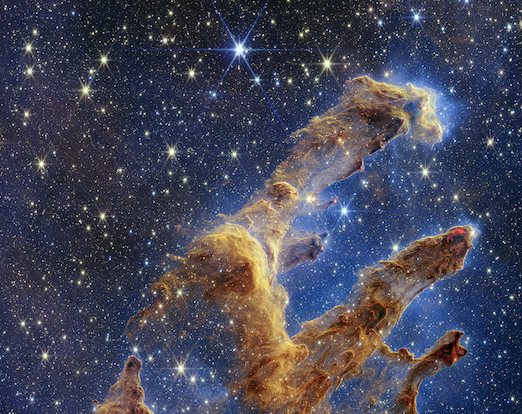The "Pillars of Creation" may be an old sight to see, but the new image from NASA's James Webb Space Telescope delivers a majestic look back at the birthplace of stars in the cosmos. They may look like rock formations in space, but these are gas and dust formations that are so dense and filled with bright stars surrounding the area.
The Webb delivers a massive development to Hubble's initial photograph in 1995, where the agency first saw the gaseous area of the pillars.
NASA James Webb Recaptures the 'Pillars of Creation

(Photo : NASA, ESA, CSA, STScI; Joseph DePasquale (STScI), Anton M. Koekemoer (STScI), Alyssa Pagan (STScI))
NASA announced via its webpage that the James Webb telescope revisited a famous site that the Hubble captured back in the mid-1990s, during its early stages in space. It is the Pillars of Creation region where there is a rock-like structure that resembles towering pillars and formations that look like majestic tall mountains.
The Pillars of Creation delivers on what seems to be a rock formation in space, but in reality, it is a concentrated gas and dust accumulation that are permeable in state.
JWST's discovery will help researchers understand more about stars and their formation, as well as the dust and gas quantities in the region.
Read Also: [WATCH] NASA's NEOWISE Telescope Releases a 12-Year Time-Lapse Movie of the Entire Sky!
What are the Pillars of Creation from JWST?
The Hubble telescope first captured this sight in 1995, and it already saw the space marvel which has confused many for its rocky look which is gas and dust accumulation.

(Photo : NASA, ESA, CSA, STScI; Joseph DePasquale (STScI), Anton M. Koekemoer (STScI), Alyssa Pagan (STScI))
Hubble's 1995 Pillar of Creation (Left) and JWST's version of the image in 2022 (Right).
JWST saw the 3D look of the area, with its mountain-like appearance in the cosmic region of its location, centering on a new study for astronomers and researchers to learn more about its existence.
NASA and its Space Discoveries
The NASA James Webb Space Telescope brought the world plentiful discoveries of the cosmos and centers on its powerful array of lenses and eyes in the skies. One of its recent findings are fingerprint-like dust clouds that surround the WR140 region whose stars are best known for their active state that releases gas and elements regularly.
Gas and elements in space help form planets and stars alike, but less dense ones are only able to form sights to see instead of the usual planets or systems known to many.
NASA is celebrating a new age in its space discoveries with its new telescope and other advancements towards knowledge and information to learn more about the space around us. The JWST aims to help NASA get deeper photos of the universe and other systems, with an in-depth look at the universe with many unfolding events taking place already.
The Pillars of Creation are best known for their dense state which outputs an array of stars, making it seem like the birthplace of the luminous objects present in the galaxy. However, it is only one region that delivers on massive stars formation in the universe, with it being the only one discovered to showcase dense pillars which look like rocks in space.
Related Article: NASA's James Webb Telescope Is Capturing A 'Treasure Trove of Record-Breaking Distant Galaxies'
This article is owned by TechTimes
Written by Isaiah Richard









